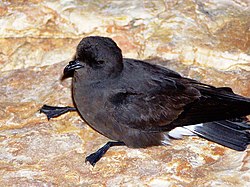European storm petrel
The European storm petrel, British storm petrel, or just storm petrel (Hydrobates pelagicus) is a small seabid. It lives in the Atlantic Ocean and the Mediterranean, around the coasts of Europe. Note that storm petrel can also refer to another group of birds, which mainly occur in the New World.
| European storm petrel | |
|---|---|

| |
| Conservation status | |
| Scientific classification | |
| Kingdom: | Animalia |
| Phylum: | Chordata |
| Order: | Procellariiformes |
| Family: | Hydrobatidae |
| Subfamily: | Hydrobatinae |
| Genus: | Hydrobates F. Boie, 1822 |
| Species: | H. pelagicus
|
| Binomial name | |
| Hydrobates pelagicus | |
| Subspecies | |
|
H. p. pelagicus (Linnaeus, 1758) | |

| |
| European and Mediterranean range of H. pelagicus (Full range extends into the South Atlantic Ocean)[1] Known or probable breeding colonies At-sea range in Northern Hemisphere summer | |
| Synonyms | |
| |
Storm petrels spend almost their whole life at sea. For breeding the come to shore, where they breed in large colonies. The bird has a well-developed sense of smell. It uses this to find its nest, or to find food, at night. In Europe, they can occasionally be seen at the Belgian coast, the Netherlands and the coast of Schleswig-Holstein.
It is one of the smallest seabirds. Its length is 16 centimetres (6.3 in) and wingspan about 37 centimetres (15 in). It weights about 27 grams (0.95 oz).It is usually black, with a white patch. The biggest known colony is probably that on Nólsoy, on the Faroe Islands. The birds can mainly be found in the ocean between Iceland, the Lofoten and the Faroe Islands.
European Storm Petrel Media
Storm petrels cannot walk on land; they shuffle on their tarsi.
Old illustrations, such as this one by John Gould, were painted from skins, and showed petrels in improbable standing positions.
The by-the-wind sailor is a small jellyfish eaten by storm petrels.
The Eleanora's falcon is a local predator on some Mediterranean islands.
"Mother Carey and her chickens". Lithograph by J. G. Keulemans, 1877.
Mother Carey. Illustration by Howard Pyle, 1902.
References
- ↑ 1.0 1.1 BirdLife International (2012). "Hydrobates pelagicus". IUCN Red List of Threatened Species. IUCN. 2012. Retrieved 26 November 2013.







